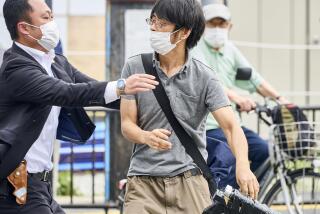Police at First Overlooked Obvious Clues
- Share via
In March 1995, five members of the Aum Supreme Truth cult used umbrellas to stab holes in sarin-filled plastic bags, releasing the deadly gas into the Tokyo subway system during morning rush hour. Within minutes, the poison had spread through subway cars and across platforms, killing 12 people and injuring more than 5,500.
Japanese authorities were caught flatfooted. Although police and prosecutors have since managed to contain and neutralize the cult, repeated efforts to put it out of business have failed, underscoring the difficulty the U.S. and other allies face in their global anti-terrorist battle.
In the hours immediately after the attack, authorities scrambled to treat the victims and figure out who would commit such a crime in one of the world’s safest societies.
Most of the clues were right in front of them, underscoring how bad police agencies can be at identifying and acting on risks that aren’t clearly outlined in their training manuals--particularly when their adversaries are highly motivated and secretive.
“The Japanese government overlooked Aum’s weapons of mass destruction capabilities for more than five years” before the attack, said Naofumi Miyasaki, associate professor at the National Defense Academy.
The cult committed a series of successively more heinous crimes over several years--including kidnapping, murder and an earlier 1994 sarin attack in Matsumoto that killed seven and injured 591--hidden behind its religious mantle and various shell chemical companies used to buy ingredients.
The cult reportedly amassed more than $1 billion in assets, forged links with the Soviet KGB and Japanese crime syndicates and infiltrated the Japanese police and military.
Each crime emboldened cult leader Shoko Asahara, analysts say. Even a chorus of complaints by the cult’s neighbors, parent groups, fleeing cult members and the media didn’t prompt the police to prosecute.
Jolted by the Tokyo subway attack, however, authorities put thousands of officers on the case and forced Japan’s turf-obsessed police, military and security agencies to finally pool resources.
Evidence that had been available all along quickly pointed to Aum, including suspicious chemical purchases by dummy Aum companies, blueprints for Aum’s sarin-making factory, aerial photos of the cult’s Russian-made helicopter and recorded contacts between Aum members and senior Russian officials.
Within days, 2,500 police officers had descended on cult compounds across Japan. Television footage showed officers entering buildings holding caged canaries to warn them of poison gas. Inside, authorities found enough ingredients to make 6.5 tons of sarin, a single drop of which can be deadly.
Patrols and data from a nationwide network of hidden highway cameras soon led police to a car near Kyoto carrying encrypted computer files with a treasure-trove of Aum membership data.
Using this information, police rounded up scores of suspects on such minor charges as trespassing, running red lights, riding stolen bicycles, libeling a fertilizer company and even failing to return a library book.
By early May, more than 300 Aum members were in custody. And on May 16, a raid on an Aum building revealed a secret alcove between the second and third floors where officers found cult leader Asahara cowering beside a pile of gold bars.
In the coming months, other investigators tracked down some of the group’s international links. Aum’s Russian helicopter, which had been smuggled into Japan via an Austrian trading company, was reportedly slated for use in an airborne sarin attack planned for late 1995.
A network of contacts in the U.S. helped recruit members, acquire high-tech equipment and raise money. A property in Australia used sheep to test the effects of the cult’s deadly chemical concoctions.
Over the next several years, Japanese prosecutors liquidated Aum’s assets and applied anti-subversive laws to the cult. But Aum lawyers used constitutional and human rights arguments and some adept legal maneuvering to keep it intact and preserve its religious status.
The cult is now subject to inspection at any time and must report its membership details and finances every three months.
Hiromi Murakami, researcher with the Washington, D.C.-based Economic Strategy Institute, says that if Aum had been a bit more competent, and Japan a bit less lucky, the death toll would have been far higher.
Aum, which has renamed itself Aleph, today has 10 bases and about 1,000 members, down sharply from the 12,000 it boasted at its peak. Asahara’s trial started in 1996. In a country where high-profile cases can last a decade or more, he remains in jail on charges including murder, kidnapping and gun and drug trafficking.
*
Makiko Inoue in The Times’ Tokyo Bureau contributed to this report.
More to Read
Sign up for Essential California
The most important California stories and recommendations in your inbox every morning.
You may occasionally receive promotional content from the Los Angeles Times.









